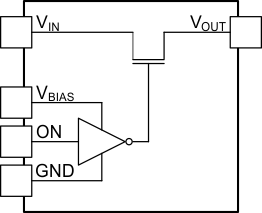ZHCSDR1 April 2015 TPS22860
PRODUCTION DATA.
8 Detailed Description
8.1 Overview
The TPS22860 is a small, ultra-low leakage current, single channel bi-driectional load switch. The device requires a VBIAS voltage and can operate over an input voltage range of 0 V to VBIAS. It can support a maximum continuous current of 200 mA. The switch is controlled by an on/off input (ON), which is capable of interfacing directly with low-voltage control signals. The TPS22860 is available in two small, space-saving 6-pin SOT-23 and SC70 packages. The device is characterized for operation over the free-air temperature range of –40°C to 85°C.
8.2 Functional Block Diagram

8.3 Feature Description
8.3.1 ON/OFF Control
The ON input controls the load switch with positive logic.
8.4 Device Functional Modes
Table 1. Functional Table
| ON | VIN to VOUT |
|---|---|
| L | Off |
| H | On |